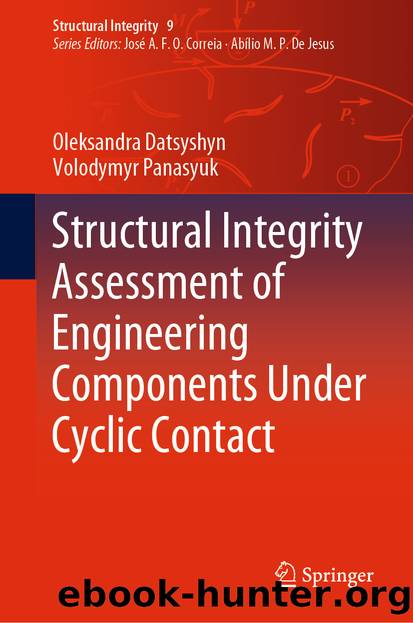Structural Integrity Assessment of Engineering Components Under Cyclic Contact by Oleksandra Datsyshyn & Volodymyr Panasyuk

Author:Oleksandra Datsyshyn & Volodymyr Panasyuk
Language: eng
Format: epub
ISBN: 9783030230692
Publisher: Springer International Publishing
Comparing the results obtained for various types of contact of the crack faces, we conclude that the difference between the results obtained for the cases of partial and full contact of the faces (the case of full contact of the crack faces is illustrated by the dashed lines in Figs. 4.9 and 4.10) is insignificant in all analyzed cases and can be observed mainly for large values of the friction coefficient fc when the counterbody is located to the right of the crack mouth. In this case, the extreme values of the SIF FII are not affected.
It is worth noting that, in analyzing the kinetics of contact of the faces of shear edge macrocracks presented in Figs. 4.9 and 4.10, we can conclude that, for the indicated direction of motion of the counterbody, the crack always starts to close from the mouth (the only exception is the case of smooth contact (fc = 0) in which the crack is simultaneously closes in the mouth and also, for a while, at the tip). Moreover, the higher the friction coefficient fc between the crack faces, the faster the process of closing. However, the behavior of the friction coefficient f exerts almost no influence on the rate of the crack closure. After the full passage of the counterbody over the crack mouth (i.e., for < −1), the crack immediately begins to open from the mouth.
Finally, it is now reasonable to recall that the maps of contact of the crack faces in Figs. 4.9 and 4.10 are plotted not for the same angle β but for different angles β = (Table 4.2). Hence, these maps illustrate the kinetics of opening displacements of the crack faces just in these cases depending on the friction coefficients f and fc.
We now consider a more general case of the behavior of shear edge cracks where the following contact conditions on the crack faces are realized: normal opening displacement of the faces, slipping with friction, and sticking. For this purpose, we plot the corresponding contact maps. The obtained dependences give more possibilities to analyze the behavior of shear edge cracks in a single cycle of contact of the bodies and enable us to estimate the relationship between FII() and the conditions of opening displacement, contact, and sticking of the faces.
The plots of the functions FII() for various values of the friction coefficients f and fc and the corresponding contact maps for the inclination angle β ≈ β* = 5π/6 are presented in Fig. 4.11. As follows from the results presented in Fig. 4.11a, c that, for fc = 0.1, the threefold increase in the friction coefficient f causes a significant reduction of the sections sticking in the crack mouth and has almost no influence on the same sections at the crack tip. For the friction coefficient fc = 0.3, no phenomena of this kind are observed: a similar increase in the coefficient of friction between the contacting bodies almost does not affect the sections of sticking (Fig. 4.11b, d). It is also worth noting that, in the case of
Download
This site does not store any files on its server. We only index and link to content provided by other sites. Please contact the content providers to delete copyright contents if any and email us, we'll remove relevant links or contents immediately.
| Automotive | Engineering |
| Transportation |
Whiskies Galore by Ian Buxton(41728)
Introduction to Aircraft Design (Cambridge Aerospace Series) by John P. Fielding(33022)
Small Unmanned Fixed-wing Aircraft Design by Andrew J. Keane Andras Sobester James P. Scanlan & András Sóbester & James P. Scanlan(32693)
Craft Beer for the Homebrewer by Michael Agnew(18087)
Turbulence by E. J. Noyes(7903)
The Complete Stick Figure Physics Tutorials by Allen Sarah(7273)
Kaplan MCAT General Chemistry Review by Kaplan(6831)
The Thirst by Nesbo Jo(6770)
Bad Blood by John Carreyrou(6483)
Modelling of Convective Heat and Mass Transfer in Rotating Flows by Igor V. Shevchuk(6359)
Learning SQL by Alan Beaulieu(6169)
Weapons of Math Destruction by Cathy O'Neil(6090)
Man-made Catastrophes and Risk Information Concealment by Dmitry Chernov & Didier Sornette(5883)
Digital Minimalism by Cal Newport;(5593)
Life 3.0: Being Human in the Age of Artificial Intelligence by Tegmark Max(5410)
iGen by Jean M. Twenge(5334)
Secrets of Antigravity Propulsion: Tesla, UFOs, and Classified Aerospace Technology by Ph.D. Paul A. Laviolette(5247)
Design of Trajectory Optimization Approach for Space Maneuver Vehicle Skip Entry Problems by Runqi Chai & Al Savvaris & Antonios Tsourdos & Senchun Chai(4962)
Electronic Devices & Circuits by Jacob Millman & Christos C. Halkias(4872)
